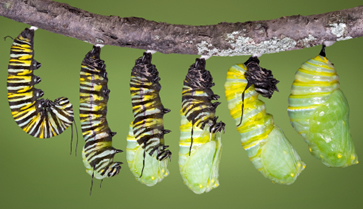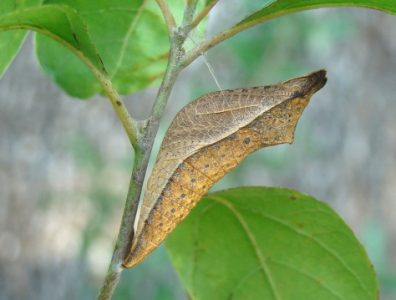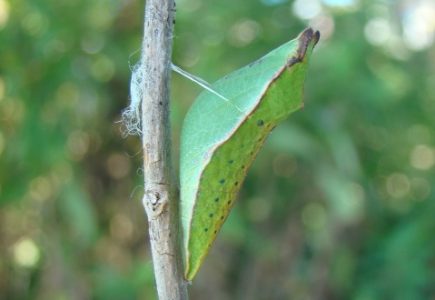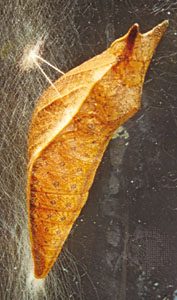Pupa (Chrysalis)
The pupa stage of the butterfly’s life cycle is the time of complete change. The pupa is also known as a chrysalis and is the stage when the slow moving caterpillar changes into a winged butterfly. The caterpillar will stop eating and begin wandering to a location to pupate. The do not usually go far, settling on twigs, trunks, or structures near their host plants but not necessarily on the host plants. Some butterfly species that over winter as a chrysalis may pupate in the leaf litter close to the ground, in crevasse’s on a tree trunk or branch, or high on a structure away from potential predators.
 This is a J-ing monarch caterpillar shedding his final exoskeleton to reveal the chrysalis underneath. The chrysalis is stationary, so it is very important that it be camouflaged in the environment. An example is the Spicebush Swallowtail’s chrysalis, which takes on a brown, yellow, or green color depending on the color of the environment. Many chrysalides are twig or leaf shaped and vary in color from yellow, brown, and green. Some chrysalides have the ability to wiggle to frighten predators.
This is a J-ing monarch caterpillar shedding his final exoskeleton to reveal the chrysalis underneath. The chrysalis is stationary, so it is very important that it be camouflaged in the environment. An example is the Spicebush Swallowtail’s chrysalis, which takes on a brown, yellow, or green color depending on the color of the environment. Many chrysalides are twig or leaf shaped and vary in color from yellow, brown, and green. Some chrysalides have the ability to wiggle to frighten predators.



These are all Spicebush Swallowtail pupa, but their resting color was developed depending on the plant material and light quality in the area.
Butterflies go through metamorphosis when being transformed from a caterpillar to an adult. The insect’s body is basically liquefied by digestive fluids and the body is restructured using specialized formative cells. While it is still a caterpillar, the adult body parts begin to form, and become fully formed during the pupa stage. The pupa stage can last as little as 2 weeks or go as long as a year. Some insects can go years in the pupa stage.
